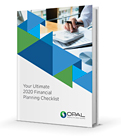Tax Organizer Checklist
By Opal Wealth Advisors | April 26, 2024The key to nailing tax season is preparation. To help you gather your thoughts and get organized, we’ve created this simple checklist on what you should be thinking about as you prepare to meet with your CPA or file online. No matter your circumstances — employed, self-employed, or happily retired — this checklist covers the most important aspects of filing your taxes this year.

Item #1: Get Your Documents in Order
Gather all the tax-related documents you’ve received in the mail, over email, or in an online portal. Having everything you need ahead of time will streamline the filing process and ensure you don’t miss any critical information that could impact your total tax bill.
To start, you’ll want to have some of your personal information on hand including:
- Social Security numbers for all family members
- Date of birth for all family members
- Your bank account’s direct deposit details (including account and routing numbers)
- Last year’s tax return
Then, you’ll need information about your income. The term “income” varies widely in the eyes of the IRS, spanning from your salary and Social Security benefits to lottery winnings, debt forgiveness, interest earned, and more.
Here are a few common income-related tax forms you may have received:
- W-2 or 1099s
- 1099-K or 1099-NEC for contract work
- 1099-INT or 1099-DIV for interest or dividend statements, respectively
- Form 1095-A if you received healthcare coverage through your state’s marketplace
- 1099-C and 1099-A forms for canceled debt
- K-1 forms for business income from an S-corporation, partnership, LLC, trust, and/or estates
- 1099-R for distributions from retirement accounts including IRA, 401(k), and/or pension plans
- SSA-1099 for Social Security benefits
Item #2: Decide if You’ll Itemize
One of the biggest decisions you need to make is whether you’ll itemize your deductions or take the standard option. For the 2024 tax year, the standard deduction is $14,600 for single filers or $29,200 for joint filers.1
For reference, around 87.3% of filers opt for the standard deduction — though this hasn’t always been the case.2 In 2017, the Tax Cuts and Jobs Act (TCJA) nearly doubled the standard deduction amount and eliminated or reduced a large number of itemized deductions. As we think ahead, however, it’s important to note that the TCJA tax provisions are due to sunset in 2025, meaning we could see more taxpayers itemizing in the future.
When deciding which is right for you, take into consideration what itemized deductions are available and whether they exceed the standard deduction. If you accrued a large amount of medical bills or gave generously to charity last year, perhaps it makes sense to itemize.
If you’re unsure which option to take, this is something you and your CPA can determine together.
Item #3: Look for Above-the-Line Deductions
Even if you do use the standard deduction, you can take advantage of above-the-line deductions to further reduce your taxable income.
Some common above-the-line deductions include:
- Retirement contributions to tax-deferred accounts
- Student loan interest
- Tuition and qualifying educational expenses
- Health savings account (HSA) contributions
- Business-related expenses
If you do opt to itemize your deductions instead, you can also deduct the following:
- Local or state taxes paid
- Mortgage interest paid
- Property taxes paid
- Childcare expenses
- Medical bills (if they were greater than 7.5% of your adjusted gross income)
- Charitable donation receipts
Item #4: Don’t Forget About Estimated Taxes
It’s possible that your tax withholdings, whether from your W-2 or retirement account distributions, aren’t going to be enough to cover your tax liability this year. Perhaps you freelance on the side, earn income from rental properties, or otherwise receive additional forms of income.
If your tax bill is expected to exceed $1,000, you are required to pay estimated taxes throughout the year or face potential tax penalties. When it comes time to file your return, make sure you include receipts or proof of your federal and state estimated tax payments.
As a reminder, estimated tax payments are due on or around:
- April 15 (for Q1)
- June 15 (for Q2)
- September 15 (for Q3)
- January 15 (for Q4 of the previous year)
Bonus Item #5: Self-Employed Documents
If you’re self-employed, your tax return will look a little different. The good news is, though your tax circumstances are more complex, there are opportunities to take additional deductions.
If you work out of your home, for example, you may qualify for the home office deduction. The key here is that the space must be used solely for the purpose of your business. You can’t claim the deduction if you work off your dining room table, for example. But if you converted a guest bedroom or garage space into a home office, then the deduction would apply.
Some other deductible expenses for self-employed individuals include:
- Office supplies
- Legal fees
- Insurance premiums:
- Health insurance premiums
- Long-term care insurance premiums
- Business overhead insurance premiums
- Phone and internet (at home and while traveling)
- Work-related meals
- Child and/or dependent care
- Depreciation of your office or work equipment
- Work-related travel expenses
Need Help Preparing for Tax Season?
While tax time comes once a year, we can help you find opportunities to minimize your tax liability all year round. We invite you to send us last year’s tax return, and we can do a free tax assessment to help get you in even better shape next year. Schedule a call now to get started.
Sources:
Be a Smart Investor
Stay up-to-date with industry-leading information and news delivered straight to your inbox.
Get our timely insights delivered to your inbox (Blog)
Please remember that past performance may not be indicative of future results. Different types of investments involve varying degrees of risk, and there can be no assurance that the future performance of any specific investment, investment strategy, or product (including the investments and/or investment strategies recommended or undertaken by Opal Wealth Advisors, LLC [“OWA]), or any non-investment related content, made reference to directly or indirectly in this commentary will be profitable, equal any corresponding indicated historical performance level(s), be suitable for your portfolio or individual situation, or prove successful. Due to various factors, including changing market conditions and/or applicable laws, the content may no longer be reflective of current opinions or positions. Moreover, you should not assume that any discussion or information contained in this commentary serves as the receipt of, or as a substitute for, personalized investment advice from OWA. OWA is neither a law firm, nor a certified public accounting firm, and no portion of the commentary content should be construed as legal or accounting advice. A copy of the OWA’s current written disclosure Brochure discussing our advisory services and fees continues to remain available upon request or at www.opalwealthadvisors.com. Please Remember: If you are a OWA client, please contact OWA, in writing, if there are any changes in your personal/financial situation or investment objectives for the purpose of reviewing/evaluating/revising our previous recommendations and/or services, or if you would like to impose, add, or to modify any reasonable restrictions to our investment advisory services. Unless, and until, you notify us, in writing, to the contrary, we shall continue to provide services as we do currently. Please Also Remember to advise us if you have not been receiving account statements (at least quarterly) from the account custodian.



